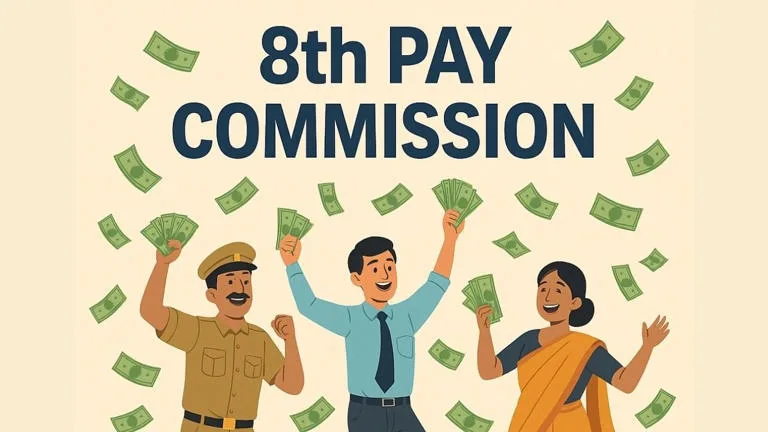The central government has fast-tracked the 8th Pay Commission process, bringing hope to over 1 crore government employees and pensioners across India. However, emerging reports suggest that while the process is being expedited, the actual salary hike might not meet the sky-high expectations that employees have been harboring for years.
Table of Contents
8th Pay Commission: Key Details at a Glance
| Aspect | Details |
|---|---|
| Formation Date | January 16, 2025 (Cabinet approved) |
| Expected Implementation | 2026-2027 |
| Beneficiaries | 1+ crore employees & pensioners |
| Expected Fitment Factor | 2.28-2.86 (down from initial hopes) |
| Projected Salary Hike | 20-35% (lower than 40% expectations) |
| Timeline | Recommendations by end of 2025 |
The reality check comes as experts now project a more conservative approach compared to the initial euphoria surrounding the commission’s formation. The Union Cabinet approved the formation of the 8th Pay Commission on January 16, 2025, marking the beginning of what could be the most anticipated salary revision in recent government history.

Why the Salary Hike Might Disappoint
While employees have been expecting massive increases of 40-45%, current projections paint a more modest picture. Experts now project between a 20% and 30% increase in overall base salary to balance employees’ and pensioners’ monthly amounts, which is significantly lower than initial expectations.
The government’s cautious approach stems from several factors including fiscal constraints, inflation management, and the need to balance public expenditure with economic stability. Unlike previous pay commissions that offered more generous hikes, the 8th Pay Commission appears to be taking a more measured approach.
For government employees looking to maximize their benefits, understanding the complete compensation structure is crucial. Check out our comprehensive government job benefits guide to learn about all the perks beyond basic salary.
Fitment Factor: The Heart of Salary Calculations
The fitment factor is the multiplier that determines how much basic salaries will increase. Under the 7th Pay Commission, the central government used a fitment factor of 2.57, which led to an increase in the minimum salary from ₹7,000 to ₹18,000.
Current projections for the 8th Pay Commission suggest a fitment factor range of 2.28-2.86, with most experts settling around 2.5-2.8. Experts believe that the fitment factor can be kept between 2.5 to 2.8, which would result in substantial but not extraordinary increases.
This conservative approach reflects the government’s attempt to balance employee expectations with fiscal responsibility, especially given the economic challenges faced in recent years.

Expected Salary Structure Changes
Beyond just salary increases, the 8th Pay Commission is considering structural reforms to the pay matrix. The suggestion involves merging specific levels: Level 1 with Level 2, Level 3 with Level 4, and Level 5 with Level 6, aimed at creating a more transparent salary structure.
These changes could address existing pay progression disparities and streamline the complex matrix that currently governs government salaries. However, such structural changes might also contribute to the overall conservative approach to salary hikes.
Impact on Different Employee Levels
The revised pay structure will affect different levels differently:
Entry-Level Employees (Level 1-2): Level 1 employees could see a salary jump of nearly 40%, assuming the current DA rate stays around 57%, making them potentially the biggest beneficiaries.
Mid-Level Employees: These employees might see more modest increases as the government attempts to compress the pay gap between different levels.
Senior Employees: Higher-level employees might face the most conservative increases as the government balances overall expenditure.
For detailed analysis of how different government job levels are affected by policy changes, visit our government career progression guide.
Timeline and Implementation Challenges
Media speculation and employee demands suggest that an announcement could be made before the end of 2025, with implementation likely in 2026-2027. This timeline puts the 8th Pay Commission roughly 10 years after the 7th, maintaining the traditional decade-long gap.
However, the expedited process doesn’t necessarily mean larger hikes. Instead, it reflects the government’s recognition of mounting pressure from employee unions and the need to address salary stagnation in the face of inflation.
What This Means for Pensioners
The commission’s recommendations will also significantly impact government pensioners. The Central government is preparing for the implementation of the 8th Pay Commission, expected to revise salaries, pensions, and allowances for over 1 crore government employees and pensioners across India.
Pensioners often benefit proportionally from pay commission recommendations, but the conservative approach might limit their gains as well.
Managing Expectations
While the 8th Pay Commission represents significant progress for government employees, managing expectations is crucial. The gap between employee hopes and fiscal reality appears to be driving the more conservative approach.
Employees should prepare for meaningful but measured increases rather than the windfall gains that social media speculation has suggested. The focus appears to be on sustainable, long-term improvements rather than dramatic short-term gains.
For the latest updates on government policies affecting public sector employees, visit the official Department of Personnel & Training website for authoritative information.
The 8th Pay Commission journey continues, but the destination might be different from what many employees initially envisioned.
Frequently Asked Questions
Q: When will the 8th Pay Commission recommendations be implemented?
A: Based on current timelines, the 8th Pay Commission is expected to submit its recommendations by the end of 2025, with implementation likely beginning in 2026-2027. The government typically takes 6-12 months to review and approve recommendations before implementation begins.
Q: Why might the salary hike be lower than expected in the 8th Pay Commission?
A: The lower-than-expected hike is attributed to fiscal constraints, the need to manage inflation, and the government’s focus on sustainable salary growth rather than dramatic increases. The projected fitment factor of 2.28-2.86 reflects a more conservative approach compared to employee expectations of 40-45% increases, with experts now projecting 20-35% overall salary improvements.








